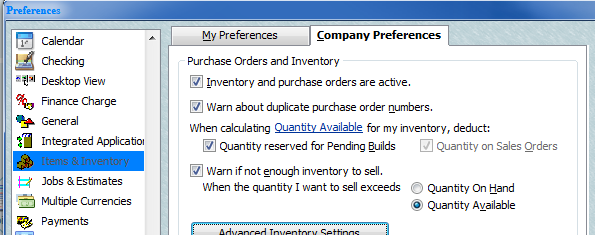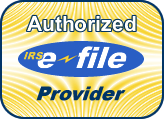It looks like the economy may finally be looking up – maybe. Still, this is no time to loosen the purse strings in terms of your business expenses. Rather, why not re-double your efforts to cut costs and boost your profitability?
Excessive expenses cause debt, which in itself can be very costly. So any money-saving actions you take will be doubly rewarding.
Effective Money Management
To cut expenses significantly, it’s necessary to poke into every corner of your company’s finances. Inventory is a good place to start. If you sell multiple units of the same item and reorder regularly, you should be using QuickBooks’ inventory-tracking tools. Go to Edit | Preferences | Items & Inventory | Company Preferences.
 Make sure that these settings are correct.
Make sure that these settings are correct.
If you need advanced features like FIFO costing, serial number and lot-tracking or inventory management at multiple locations, contact me about upgrading to Enterprise Solutions.
You should be stocking your inventory to match the pace of sales. You don’t want to be caught short, nor do you want to be sitting on too much and tying up money unnecessarily. QuickBooks can help, but you’ll need to calculate the sweet spot for each item. Several built-in reports can help, including:
- Inventory Valuation Summary. Displays the current asset and retail value of each item and inventory as a whole
- Inventory Valuation Detail. Shows how individual transactions have affected the value of your inventory
- Inventory Stock Status By Item. Helps you set up smart reordering procedures
- Open Purchase Orders. Outlines each purchase order and its expected delivery date
To maintain profitable inventory levels and minimize expenses, you’ll need to study QuickBooks’ related reports regularly. When you’re making buying decisions, consider factors like reorder turnaround time and seasonal sales upticks.
Ratio reports, like profit over sales, can also be very telling. QuickBooks does not supply these, but we can help you create them in Excel.
Use the Tools You have Available
The efforts you make toward reducing expenses in other ways can result in more savings than you might think. Here are some actions you can take that will accelerate your cash flow:
Use QuickBooks’ budgeting tools. This doesn’t need to be as onerous as you might expect – you can start by pulling in your real data from the previous year as a base. Build in line items for ongoing accounting support like QuickBooks maintenance. Click on Company | Planning & Budgeting | Set Up Budgets.
Selecting the option, Create budget from previous year will simplifie your task.
Minimize your April 15 obligation with year-round tax planning. Work with us throughout the year on the next year’s taxes to, for example, make smarter quarterly payments, and we’ll help you reduce your tax bill by making better decisions every day.
Get discounts by paying invoices early. You can set up a custom field in vendor records to track this. Get to know which vendors offer early discounts — and take advantage of them.
Analyze the cost-effectiveness of your transportation. Can you replace some in-person sales calls with web-based communication? Make sure that your delivery routes and sales call paths are efficient.
Change product/service prices to build in your own cost increases. Do it across the board, in small increments. It may not even be that noticeable to customers.
Talk to us about establishing a line of credit. We’ll help you determine if this is a viable option for emergencies. It’s cheaper than using credit cards.
Cross-train employees. Have employees train each other on their tasks where it makes sense. You can avoid costly temp help and relieve overworked departments.
Don’t try to change everything at once. Establishing these new procedures will require some extra work. And you may not notice a reduction in expenses immediately. But over time, you will see a positive change — one that will give you extra dollars and hours to invest in making your company flourish.
© 2012, Bruce Mc. All rights reserved.











